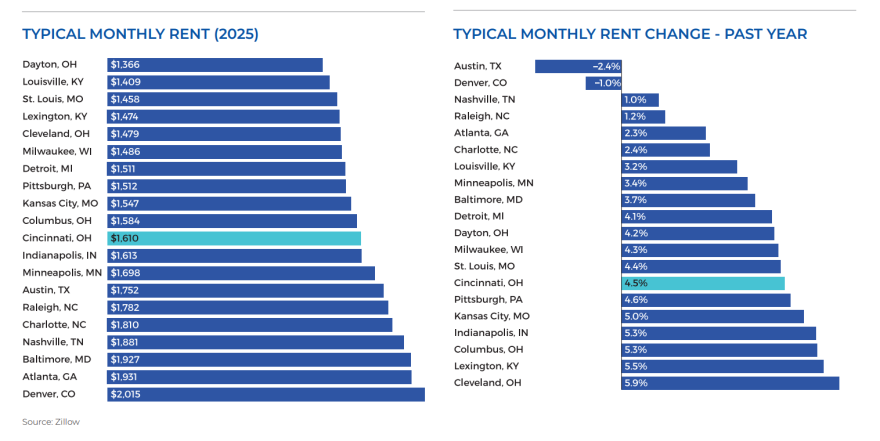The Cincinnati metro area grew by about 20,000 people in 2024, according to a new report from the Cincinnati Regional Chamber.
It's the strongest year of population growth in the region since at least 2010, according to Director of the Chamber's Center for Research and Data Brandon Rudd.
"Notably, over 5,000 of those [new residents], over a quarter, were in Hamilton County itself — our core county," Rudd told WVXU. "So that reversed a long period of the outer counties, the suburban counties, dominating population growth."
Rudd says it's a step in the right direction, but points out the fourth annual State of the Region report shows the Cincinnati metro is not growing as quickly as many peer cities.
The report projects a few possible scenarios for population growth over the next few decades. The most optimistic scenario predicts reaching more than 2.8 million people by 2050.

Rudd says reaching that goal would require policy changes.
"One of the things we call out in the report is our governmental fragmentation," Rudd said. "Metro areas that have a larger percentage of their population in the core city are, on average, growing faster. And that's kind of a proxy for government fragmentation — it's easier to navigate some of the governmental factors when you have one core city that's taking up much of the metro area. But in Cincinnati, only 14% of our population lives in the city of Cincinnati [and] the rest live in the outlying suburbs."
Rudd says even if government consolidation is unlikely, local officials can make an effort to collaborate more. He says other changes are needed as well, like zoning reform and greater investment in things like infrastructure, transportation, and the electrical grid.
Even the baseline projection, which estimates population growth based on current trajectory, has gone down compared to previous projections. Rudd says that's partly because of a slight decrease in life expectancy, as well as a decrease in immigration.
"In the Cincinnati region, about two-thirds of our growth over the past few years has been because of immigration," Rudd said.
Housing and affordability
Another factor that correlates to population growth is housing production. In that area, the Cincinnati region improved compared to last year's report.
"[The region] permitted just over 7,000 housing units last year," Rudd says, which is about 14% more than the year before. "But Columbus permitted almost double that. And Austin, Texas, which is a similar size metro area, permitted over 30,000 units."
Rudd says Austin, in particular, is a leader on housing reform: "They've made the types of zoning reforms, the types of permitting reforms, and the types of investments in affordable housing that we think are necessary to help our region grow and to make sure that housing is affordable for everyone."
One metric to track affordability is the percentage of renters who spend at least half their income on housing. On a list of 20 peer metro areas, Cincinnati has the third highest percentage of these severely cost-burdened renters. And, that percentage increased compared to the year before.
Average rent in the Cincinnati area increased 4.5% between May 2024 and May 2025, the seventh highest increase among peer regions. During the same time period, average rent in Austin, Texas, decreased 2.4%.

Economy and income
The report analyzes data on the local economy including the region's largest companies and industries, job growth and unemployment, and income.
Overall, median household income increased to $81,489, up from about $75,000 in last year's report.
That number varies greatly by geography and by race. Median household income in Warren County is nearly $112,000, nearly double that of Bracken County, Kentucky.
And the increase in median household income was not even distributed.
"The median Black family saw their household income increase pretty substantially, actually, by $3,500 since last year's report," Rudd said. "But the median white family saw their incomes grow even more."
As a result, the racial income gap grew by more than $2,000 compared to the last report.
Read more:



